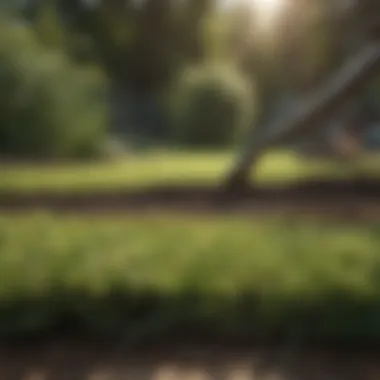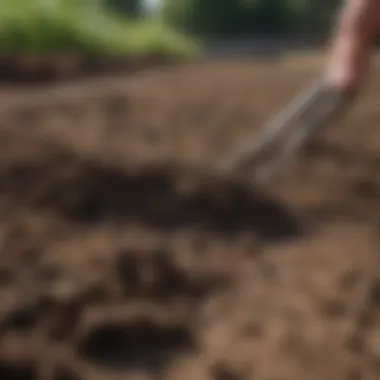Placing Sod on Existing Grass: A Comprehensive Guide


Intro
Placing sod on existing grass, while seemingly straightforward, holds complexities that merit deeper examination. The methods employed can vary, as might the motivations behind undertaking such landscaping efforts. Understanding the nuances of this practice is essential for both novice gardeners and those with more experience. The benefits, such as the improvement of yard aesthetics and potential increases in property value, come with challenges. We will explore practical strategies, considerations, and risks associated with this process.
Current Trends in Agriculture and Horticulture
Overview of Recent Innovations
Recent advancements in horticulture have introduced a range of innovative techniques to optimize sod placement. Precision agriculture technologies now allow for more data-driven decisions regarding soil health and moisture levels. Tools like soil sensors and automated irrigation systems have become commonplace, providing detailed insights that help in effectively managing sod installation.
Sustainable Practices Gaining Popularity
Sustainability has become a focal point in agricultural initiatives. Many gardeners are opting for environmentally friendly practices when placing sod. This includes selecting native grass varieties that require less water and fertilizer. Organic compost is often integrated into the soil preparation process to enhance its quality without relying on synthetic chemicals. The aim is to create a healthier ecosystem that can support robust sod growth while being mindful of environmental impacts.
Essential Farming Techniques
Soil Health Management
Healthy soil is the cornerstone of successful sod installation. Prior to placing sod, soil testing is recommended. This can identify nutrient deficiencies and pH imbalances that, if untreated, may hinder sod establishment. Techniques like aeration can improve drainage and promote root growth. Additionally, incorporating organic matter into the soil can enhance its structure, facilitating the movement of air and water.
Pest and Disease Control Strategies
Monitoring for pests and diseases is essential during and after sod placement. Consistent checks can prevent infestations in their early stages. Integrated Pest Management (IPM) techniques can be effective, combining cultural, physical, and biological methods to control issues. For instance, introducing beneficial insects can help reduce the population of harmful pests in the garden.
Tools and Technology in Farming
Overview of Advanced Farming Tools
The landscape of sod installation has been transformed by the introduction of specialized tools. Sod cutters make the task of removing existing grass easier, while rollers assist in ensuring proper contact between the sod and soil. Furthermore, tools like soil cultivators can prepare the ground, breaking it apart for better sod integration.
Case Studies on the Use of Technology
Studies in regions that have embraced technology show marked improvements in sod placement success rates. For example, a case study conducted in a metropolitan area highlighted how homeowners using advanced irrigation technology saw a significant reduction in water usage while maintaining lush lawns. Such instances highlight the productive synergy between traditional gardening methods and modern technological innovations.
"Integrating advanced tools in sod placement can yield sustainable results while maintaining ecological health."
Preface
Placing sod on existing grass is a relevant topic for gardeners and homeowners alike. This practice allows for quick transformation of a lawn, enhancing its appearance and health. It is crucial to understand the process to ensure success from the outset. By examining the right techniques and considerations, one can cultivate a lush green space that not only looks pleasing but also supports local ecosystems.
Benefits of Installing Sod
Sod can revitalize tired or sparse grass. When placed correctly, it offers immediate aesthetic benefits, saving time compared to traditional seeding methods. Moreover, sod provides a mature root system, which offers better resilience against environmental stressors.
However, challenges may arise. The compatibility of existing grass with new sod is essential. This article will delve into various aspects, from preparation to post-installation care, ensuring comprehensiveness in coverage.
Understanding the Basics of Sod
Sod is a pre-grown layer of grass that is cultivated with a solid foundation of soil. It is harvested in sections, often referred to as “sod rolls” or “sod squares.” Understanding the requirements of sod helps in the selection process. Different types of sod exist, such as Kentucky Bluegrass, Bermuda grass, or Fescue, which have distinct growth characteristics and compatibility needs with existing grass.
When considering sod, speak with local suppliers to learn about suitable varieties for the local climate. This knowledge is fundamental, as it affects the longevity and health of the lawn.
Why Install Sod on Existing Grass?
There are several reasons to choose sod over seeds when updating a lawn. First, sod provides instant coverage. Where grass has begun to thin or die, sod can fill in gaps seamlessly. This can be particularly pleasing during the growing season when immediate results are desired.


Sodding is also effective in erosion prevention. Newly laid sod helps improve soil stability, protecting against run-off and promoting better moisture retention.
In addition, sod can improve the biodiversity of your lawn. By carefully choosing types of sod that complement existing varieties, one can create an environment that supports a wider range of beneficial insects and soil microorganisms.
"The integration of sod requires careful planning and understanding the existing landscape."
Assessing Your Existing Grass
Assessing your existing grass is crucial before proceeding with sod placement. Understanding the condition of your current lawn helps to identify the most effective approach for integrating sod. Recognizing the nuances of your grass health, spots that may hinder growth, and compatibility between different grass types enhances the likelihood of successful new sod establishment. This assessment not only saves time and resources but also results in a more thriving landscape overall.
Evaluating Grass Health
Start by examining the overall vitality of your grass. Look for signs of stress such as discoloration, wilting, or sparse growth. Healthy grass should be vibrant green and dense. You can do a simple tug test. Gently pull on the grass blades; they should resist and stay rooted. If they come up easily, it may indicate shallow or compromised root systems.
Consider soil moisture. Overly dry or waterlogged conditions affect root penetration and sod acceptance. Testing soil pH is also valuable. Optimal pH levels for grass growth typically range between 6.0 and 7.0. If levels fall outside this range, it could hinder new sod development.
Identifying Problem Areas
Next, focus on specific trouble spots in your lawn. Common issues include patches lacking growth, areas with excessive weed presence, or parts of the yard prone to water accumulation. Observing these areas allows for targeted solutions during sod installation.
Consider factors like sun exposure and foot traffic. Shady areas may not support all grass types, while heavily trodden spots may require more durable varieties. Compaction of the soil in these areas may also necessitate remediation before sod placement.
Determining Grass Type Compatibility
Understanding the grass type already present in your lawn is critical for successful integration of new sod. Some grass types do not blend well together, which can lead to uneven growth. For instance, Kentucky Bluegrass may struggle when placed over fescue, as their growth patterns differ significantly.
Research characteristics of your existing grass type. Is it cool-season or warm-season grass? Knowing this helps in selecting compatible sod for optimal performance. The right choice can yield a cohesive lawn aesthetic and reduce competition for nutrients.
"Assessing your existing grass is not just the first step; it's foundational for lasting success in sod placement."
By comprehensively evaluating your grass health, identifying problem areas, and determining compatibility, you set the stage for effective sod installation. This preparation phase is essential, enabling you to make informed decisions that promote the health and beauty of your landscape.
Preparation for Sod Placement
Preparation for sod placement is a crucial step in creating a successful sod installation. If you are placing sod on existing grass, proper planning and preparation can significantly impact the outcomes. Ignoring this phase could lead to issues such as sod failure, poor establishment, and unwanted competition between the new sod and existing grass.
Selecting the Right Type of Sod
Choosing the appropriate type of sod is fundamental. Different grasses have varying requirements for light, moisture, and maintenance. For instance, Kentucky bluegrass is favorable in cooler climates, while Bermudagrass thrives in warmer areas. Understanding your local climate and grass adaptability ensures you select sod that will grow successfully with minimal stress.
Consider the following factors when selecting sod:
- Climate adaptability: Grasses have specific temperature ranges.
- Sunlight requirement: Some types need more direct sunlight than others.
- Use cases: High traffic areas may require sturdier varieties.
Top Grass Varieties:
- Fescue: Tolerates shade well.
- Zoysia: Durable and heat tolerant.
- Perennial Ryegrass: Quick to germinate, useful for quick patches.
Soil Health Assessment
Soil quality directly influences sod growth. A thorough soil health assessment allows you to understand pH, nutrient levels, and overall soil structure. Conducting a soil test is beneficial; it can direct necessary amendments before placing sod.
Key aspects to evaluate include:
- pH Levels: Ideally between 6.0 and 7.0 for most grasses.
- Nutrient Content: Nitrogen, phosphorus, and potassium levels need to be adequate for grass growth.
- Organic Matter: Enhancing soil with organic compost improves soil structure and moisture retention.


Mowing and Watering Existing Grass
Prior to sod placement, it is critical to prepare the existing grass. Start by mowing the current grass to a height of about two inches. This height not only reduces competition for light but also minimizes issues with the existing grass. Additionally, watering the grass a day before installation keeps the soil moist but not soggy, allowing the new sod to better adhere.
Preparing the Soil Surface
The final step in preparation is to address the soil surface beneath your new sod. This involves the following:
- Clearing Debris: Remove any rocks, sticks, or other debris.
- Cultivating the Soil: Use a garden fork or tiller to break up the topsoil. This helps improve sod contact and drainage.
- Leveling: Rake the soil surface to create a smooth, even area for installation.
This preparation phase not only sets up your new sod for success but also minimizes future issues related to drainage and grass compatibility. By emphasizing these critical steps, you ensure that the sod can grow well and integrate with the existing grass without failure.
Final Thought: Proper preparation acts as the foundation for establishing a healthy lawn. Neglecting this step can lead to complications, making it important to carry out each phase methodically.
Techniques for Placing Sod
Understanding the techniques for placing sod on existing grass is essential for achieving a healthy and vibrant lawn. Each method has its own benefits, and the choice of technique can directly influence the success of sod establishment. By learning about these techniques, gardeners can make informed decisions that align with their yard's unique conditions and their specific landscape goals. Effective implementation of these sod-laying approaches allows for better integration of new grass, minimizing disruption to the existing environment while promoting quicker recovery and establishment.
Layering Sod over Existing Grass
Layering sod is a technique that involves placing new sod on top of existing grass without removing the old turf. This method can be beneficial when existing grass is relatively healthy but has open patches or areas that need improvement. One major advantage of this approach is that it can help retain soil moisture and provide immediate cover, preventing erosion. Moreover, since the underlying grass remains intact, the soil stays aerated.
Before proceeding, it's advisable to mow the existing grass low to reduce height differences. Clearing any debris and ensuring even contact between the layers are key for minimizing air pockets. Watering the old grass lightly before layering can promote better adherence. Pay attention to overlapping sod edges to ensure full coverage, and check for any exposed areas.
Using a Sodding Fork Method
The sodding fork method is rather practical when tackling uneven surfaces or improving specific areas. This approach involves using a garden fork or a specialized sodding fork to pierce the existing grass and soil.
This technique allows for better drainage and soil aeration. It creates small holes that facilitate the rooting system of the new sod to penetrate deeper into the soil. The process is somewhat labor-intensive, requiring a careful and methodical approach. It's recommended to aerate the soil thoroughly to create optimal conditions for the sod roots to establish. After placing the sod pieces, watering them is crucial for ensuring moisture retention.
Adopting a Roll-Out Approach
The roll-out approach involves laying sod rolls, or strips, in a shingle-like pattern. This technique is straightforward and widely used for larger areas. It enhances the speed of installation and minimizes seams, which can sometimes lead to moisture loss.
When employing this method, begin at the furthest point of your yard, working your way back towards an exit point. It is best to stagger the seams in each row to create a more cohesive appearance. After laying the rolls, it is essential to gently press them down to eliminate air pockets.
Water these areas immediately after installation, ensuring consistent moisture for the first couple of weeks. Proper attention is critical to enable the new sod to meld with the existing grass effectively.
In summary, investing time to understand and execute the right technique for placing sod can significantly enhance the results. Each method has specific steps and considerations that can lead to a thriving lawn. Careful preparation and follow-up maintenance ensure the newly laid sod establishes firmly, contributing to the overall health of your landscape.
Post-Installation Care
Post-installation care is a crucial phase in ensuring the success of sod placed over existing grass. The new sod requires specific attention to thrive and establish roots properly. Neglecting this step can lead to problems such as uneven growth, bald spots, and even sod failure. It is vital to provide the proper conditions that will allow the new sod to integrate effectively with the existing grass beneath it.
Watering Strategies for New Sod
Watering is one of the most critical components of post-installation care. Adequate moisture is essential for the new sod to take root and establish itself. Initially, the sod should be watered immediately after installation. This helps to settle the sod into the soil and ensures that there is no air gap, which could hinder root growth.
After this initial watering, the following strategies can be employed:
- Daily Watering: For the first two weeks, water the sod daily. This hydration helps sustain the newly laid sod as it begins to grow roots.
- Deep Watering: Aim for a depth of 6 to 8 inches with each watering session. This encourages roots to grow deeper rather than staying close to the surface.
- Adjusting Frequency: After the first two weeks, reduce the frequency to about every other day. Eventually, transition to once a week or as needed based on weather conditions.
Managing Foot Traffic
Managing foot traffic on the newly placed sod is crucial for its healthy establishment. The first few months post-installation are particularly sensitive. Here are some points to bear in mind:


- Restrict Access: Limiting foot traffic for at least two to three weeks helps the sod develop roots without disturbance. It’s advisable to mark areas as off-limits to protect the new investment.
- Create Pathways: If foot traffic is unavoidable, consider using temporary pathways or boards to disperse weight and minimize soil compaction.
- Monitor Activity: Keep an eye on any activity over the sod. Too much pressure can lead to areas getting compacted, which can impair root growth.
Fertilization and Nutrient Management
Ensuring correct fertilization and nutrient management after laying sod is vital for sustaining healthy growth. Fertilizers provide the necessary nutrients to support root development and encourage lush green growth.
- Initial Fertilization: Apply a starter fertilizer to the sod after installation. Use a product with a balanced ratio of nitrogen, phosphorus, and potassium. Follow the manufacturer's instructions regarding the quantity.
- Scheduled Fertilization: After the initial application, a soil test can help determine when to fertilize further. Typically, a second application may be required in late spring and a final application in early fall.
- Organic Options: Consider using organic fertilizers that release nutrients more slowly. This can lead to long-term health and sustainability of the grass.
Ongoing Maintenance and Monitoring
Maintaining the sod requires vigilance and regular monitoring. There are multiple aspects to focus on during this period:
- Regular Inspections: Check for any signs of disease or pests. Early detection can save significant effort later.
- Trimming and Mowing: Once the sod begins to establish, mowing can commence. Set the mower blade to a higher setting initially to avoid stress on the young sod.
- Weed Management: Watch for weed growth as well. Taking swift action to remove weeds ensures that resources are not being stolen from the young sod.
Proper post-installation care is vital. Neglecting any part of this process could undermine the entire effort of laying new sod.
Common Challenges and Solutions
When laying sod over existing grass, various hurdles can arise. Understanding these challenges helps in devising effective solutions. Problems like weed growth, soil compaction, and pest issues not only affect the success of sod installation but also the long-term health of your lawn. This section will explore these challenges and offer practical remedies.
Dealing with Weed Growth
Weeds are one of the most common adversaries in sod installation. They can thrive even in the thin layers of soil that remain exposed after preparing the existing grass. When placing sod, weeds may compete with the new grass for nutrients, water, and sunlight, thus hindering its establishment. To combat this, it is essential to take proactive measures before and after sod placement.
- Prevention: Use a non-selective herbicide on the existing grass a few days before installation. This will help kill off existing weeds and reduce their chances of regrowth.
- Removal: Hand-pulling weeds before installing sod can also be effective. Focus on perennial weeds, which tend to regrow after cutting.
- Mulching: Apply organic mulch on the edges after installation. This can suppress weed growth while maintaining moisture.
Regular monitoring is key. If weeds do appear, applying a suitable herbicide that is safe for new sod is crucial, often requiring waiting periods as specified on the product.
Addressing Soil Compaction Issues
Soil compaction can significantly impede the growth of sod. Compacted soil limits water penetration, reduces root growth, and decreases air circulation within the soil. This can lead to stressed and unhealthy grass, no matter how well the sod is installed.
To address soil compaction, consider these practices:
- Aeration: Aerating the soil before laying sod creates channels for air and water, improving soil health. The use of a core aerator is recommended for better results.
- Soil Amendment: Mixing organic matter into the soil can help reduce compaction while enhancing soil structure. Compost is a great choice for this purpose.
- Regular Maintenance: After installation, avoid excessive foot traffic on new sod, particularly during the first few weeks. This helps keep the soil loose and conducive to root growth.
Identifying Disease or Pest Problems
Diseases and pests can pose a severe threat to newly laid sod. It is essential to be vigilant about these issues, as they can quickly devastate a lawn if left unchecked. Common signs of problems include discoloration, wilting, or visible insects.
- Observation: Regularly check the sod for any signs of distress. Look for patches of yellowing, which can signal fungal infection.
- Consult Professionals: If disease or pest issues are suspected, seeking help from local agricultural extension services or pest control professionals can provide valuable insights.
- Preventive Measures: Applying fungicides and insecticides should be part of an integrated pest management approach. Make sure to choose products appropriate for sod health and your local environment.
Proactive and informed actions during sod placement can save time, money, and efforts in maintaining a lush, healthy lawn.
In summary, addressing these common challenges is essential for successful sod placement on existing grass. By focusing on weed management, soil health, and disease or pest monitoring, lawn enthusiasts can achieve beautiful, resilient landscapes.
Epilogue
In the arena of home gardening, the application of sod on existing grass is an intricate practice that requires a careful approach. The conclusion of this article serves to synthesize the various elements discussed while reinforcing the significance of understanding the complete process. Implementing sod correctly can rejuvenate and improve your lawn significantly, enhancing both its aesthetic appeal and health.
Recap of Key Takeaways
- Thorough Assessment: Evaluate the existing grass's health and type to ensure compatibility.
- Soil Preparation: Properly prepare the soil surface and check for compaction or nutrient deficiencies before laying sod.
- Installation Techniques: Pay attention to various methods for placing sod, as each has unique advantages.
- Post-Installation Care: Apply rigorous care after installation by watering appropriately and monitoring foot traffic.
- Addressing Challenges: Be prepared to deal with common issues such as weed growth and pest problems.
Overall, combining these practices leads to success in sod installation on existing grass.
Encouragement for Home Gardeners
For home gardeners, the task of placing sod is an opportunity for learning and growth. Embrace the challenges as part of the journey. Remember, a well-tended lawn not only enhances property value but also contributes positively to your environment.
Start with realistic expectations. It may take some time for the new sod to establish, but with diligence and care, the results can be rewarding. Consider joining local gardening forums or communities, such as on Reddit, to share experiences and gather insights. The more you engage with your garden, the more it will flourish.



